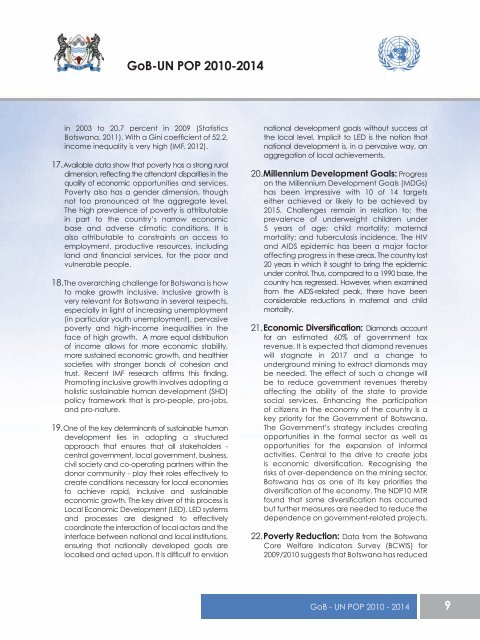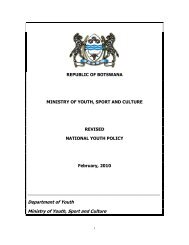GoB-UN POP 2010-2014 - UNFPA Botswana
GoB-UN POP 2010-2014 - UNFPA Botswana
GoB-UN POP 2010-2014 - UNFPA Botswana
- No tags were found...
Create successful ePaper yourself
Turn your PDF publications into a flip-book with our unique Google optimized e-Paper software.
<strong>GoB</strong>-<strong>UN</strong> <strong>POP</strong> <strong>2010</strong>-<strong>2014</strong>in 2003 to 20.7 percent in 2009 (Statistics<strong>Botswana</strong>, 2011). With a Gini coefficient of 52.2,income inequality is very high (IMF, 2012).17. Available data show that poverty has a strong ruraldimension, reflecting the attendant disparities in thequality of economic opportunities and services.Poverty also has a gender dimension, thoughnot too pronounced at the aggregate level.The high prevalence of poverty is attributablein part to the country’s narrow economicbase and adverse climatic conditions. It isalso attributable to constraints on access toemployment, productive resources, includingland and financial services, for the poor andvulnerable people.18. The overarching challenge for <strong>Botswana</strong> is howto make growth inclusive. Inclusive growth isvery relevant for <strong>Botswana</strong> in several respects,especially in light of increasing unemployment(in particular youth unemployment), pervasivepoverty and high-income inequalities in theface of high growth. A more equal distributionof income allows for more economic stability,more sustained economic growth, and healthiersocieties with stronger bonds of cohesion andtrust. Recent IMF research affirms this finding.Promoting inclusive growth involves adopting aholistic sustainable human development (SHD)policy framework that is pro-people, pro-jobs,and pro-nature.19. One of the key determinants of sustainable humandevelopment lies in adopting a structuredapproach that ensures that all stakeholders -central government, local government, business,civil society and co-operating partners within thedonor community - play their roles effectively tocreate conditions necessary for local economiesto achieve rapid, inclusive and sustainableeconomic growth. The key driver of this process isLocal Economic Development (LED). LED systemsand processes are designed to effectivelycoordinate the interaction of local actors and theinterface between national and local institutions,ensuring that nationally developed goals arelocalised and acted upon. It is difficult to envisionnational development goals without success atthe local level. Implicit to LED is the notion thatnational development is, in a pervasive way, anaggregation of local achievements.20. Millennium Development Goals: Progresson the Millennium Development Goals (MDGs)has been impressive with 10 of 14 targetseither achieved or likely to be achieved by2015. Challenges remain in relation to: theprevalence of underweight children under5 years of age; child mortality; maternalmortality; and tuberculosis incidence. The HIVand AIDS epidemic has been a major factoraffecting progress in these areas. The country lost20 years in which it sought to bring the epidemicunder control. Thus, compared to a 1990 base, thecountry has regressed. However, when examinedfrom the AIDS-related peak, there have beenconsiderable reductions in maternal and childmortality.21. Economic Diversification: Diamonds accountfor an estimated 60% of government taxrevenue. It is expected that diamond revenueswill stagnate in 2017 and a change tounderground mining to extract diamonds maybe needed. The effect of such a change willbe to reduce government revenues therebyaffecting the ability of the state to providesocial services. Enhancing the participationof citizens in the economy of the country is akey priority for the Government of <strong>Botswana</strong>.The Government’s strategy includes creatingopportunities in the formal sector as well asopportunities for the expansion of informalactivities. Central to the drive to create jobsis economic diversification. Recognising therisks of over-dependence on the mining sector,<strong>Botswana</strong> has as one of its key priorities thediversification of the economy. The NDP10 MTRfound that some diversification has occurredbut further measures are needed to reduce thedependence on government-related projects.22. Poverty Reduction: Data from the <strong>Botswana</strong>Core Welfare Indicators Survey (BCWIS) for2009/<strong>2010</strong> suggests that <strong>Botswana</strong> has reduced<strong>GoB</strong> - <strong>UN</strong> <strong>POP</strong> <strong>2010</strong> - <strong>2014</strong> 9







